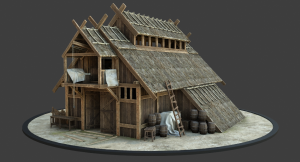
Viking architecture is known for its use of large stones and wooden beams to construct their dwellings and buildings. Stone walls were constructed using the dry-stone technique, which involved placing the stones in a herringbone pattern without using mortar or other materials. Wooden beams and planks were used to form roofs, and both stone and wood construction techniques were used to construct churches, halls, and other structures.
Aztec design was based on a combination of their own cultural traditions as well as influences from their neighbors, including the Mayans. Aztec architecture had a distinct geometrical style with a focus on symmetry and balance. Buildings were constructed out of adobe or stone and often featured stepped pyramids, as well as temples and palaces. Fountains and water features were also common in Aztec architecture. Decorative elements such as mosaics and stone sculptures were often incorporated into the designs of Aztec buildings. As a result, many structures from this period remain standing today as reminders of the advanced architecture and artistry achieved by the Aztecs.
Both Viking and Aztec architecture were influenced by their respective cultures, yet each had its own unique features that set it apart. Both used stone and wood to construct their dwellings and buildings, but the techniques used were different. Viking architecture featured dry-stone construction, while Aztec design was more focused on geometrical shapes and symmetry. Both cultures are known for their impressive structures, which remain to this day as monuments of a bygone era.
Furthermore, both styles feature intricate and ornate decorative elements that demonstrate the skill and artistry of their respective cultures. Whether one is admiring Viking or Aztec architecture, it’s clear to see the craftsmanship and care put into these structures. The legacy of each culture still remains today, a testament to the innovative and creative minds behind them.
Ultimately, both Vikings and Aztecs left their mark on the world with their unique architecture. While each had its own distinct style, they both achieved great feats in terms of design and construction, leaving behind a rich cultural legacy that still stands today. Whether it be the impressive stone walls of Viking buildings or the intricate detail of Aztec structures, one can’t deny the impressive architecture of both.
